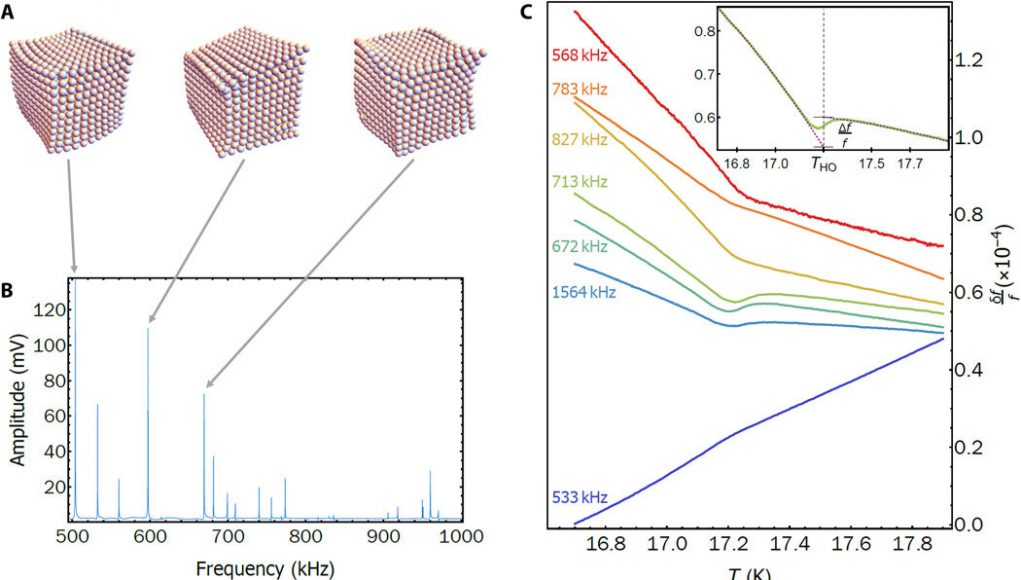Extreme temperature can do strange things to metals. In severe heat, iron ceases to be magnetic. In devastating cold, lead becomes a superconductor.
For the last 30 years, physicists have been stumped by what exactly happens to uranium ruthenium silicide (URu2Si2) at 17.5 kelvin (minus 256 degrees Celsius). By measuring heat capacity and other characteristics, they can tell it undergoes some type of phase transition, but that’s as much as anyone can say with certainty. Plenty of theories abound.
A Cornell collaboration led by physicist Brad Ramshaw, the Dick & Dale Reis Johnson Assistant Professor in the College of Arts and Sciences, used a combination of ultrasound and machine learning to narrow the possible explanations for what happens to this quantum material when it enters this so-called “hidden order.”
Their paper, “One-Component Order Parameter in URu2Si2 Uncovered by Resonant Ultrasound Spectroscopy and Machine Learning” published March 6 in Science Advances.
“In uranium ruthenium silicide, we have no idea what the electrons are doing in the hidden order state,” said Ramshaw, the paper’s senior author. “We know that they don’t become magnetic, we know that they don’t become superconducting, but what are they doing? There are a lot of possibilities—orbital order, charge density waves, valence transitions—but it’s hard to tell these different states of matter apart. So the electrons are ‘hiding,’ in that sense.”
Find your dream job in the space industry. Check our Space Job Board »
Ramshaw and his doctoral student Sayak Ghosh used high-resolution ultrasound spectroscopy to examine the symmetry properties of a single crystal of URu2Si2 and how these properties change during the hidden order phase transition. Most phase transitions are accompanied by a change in symmetry properties. For example, solids have all their atoms lined up in an organized way, while liquids do not. These changes in symmetry aren’t always obvious, and can be difficult to detect experimentally.
“By looking at symmetry, we don’t have to know all the details about what the uranium is doing, or what the ruthenium is doing. We can just analyze how the symmetry of the system looks before the phase transition, and how it looks after,” Ramshaw said. “And that lets us take that table of possibilities that theorists have come up with and say, ‘Well, these are not consistent with the symmetry before and after the phase transition, but these are.’ That’s nice, because it’s rare that you can make such definitive yes and no statements.”
However, the researchers encountered a problem. To analyze the ultrasound data, they normally would model it with wave mechanics. But to study the purest form of URu2Si2, they had to use a smaller, cleaner sample. This “oddly-shaped little hexagon chip,” Ramshaw said, was too tiny and had too much uncertainty for a straightforward wave-mechanics solution.
So Ramshaw and Ghosh turned to Eun-Ah Kim, professor of physics and a co-author of the paper, and her doctoral student Michael Matty, to produce a machine-learning algorithm that could analyze the data and uncover underlying patterns.
“Machine learning is not only for an image-like data or big data,” Kim said. “It can dramatically change the analysis of any data with complexity that evades manual modeling.”
“It’s hard, because the data is just a list of numbers. Without any sort of method, it has no structure, and it’s impossible to learn anything from it,” said Matty, the paper’s co-lead author with Ghosh. “Machine learning is really good at learning functions. But you have to do the training correctly. The idea was, there is some function that maps this list of numbers to a class of theories. Given a set of numerically approximated data, we could do what is effectively regression to learn a function that interprets the data for us.”
The results from the machine-learning algorithm eliminated roughly half of the more than 20 likely explanations for the hidden order. It may not yet solve the URu2Si2 riddle, but it has created a new approach for tackling data analysis problems in experimental physics.
The team’s algorithm can be applied to other quantum materials and techniques, most notably nuclear magnetic resonance (NMR) spectroscopy, the fundamental process behind magnetic resonance imaging (MRI). Ramshaw also plans to use the new technique to tackle the unruly geometries of uranium telluride, a potential topological superconductor that could be a platform for quantum computing.
Provided by: Cornell University
More information: Sayak Ghosh et al. One-component order parameter in URu2Si2 uncovered by resonant ultrasound spectroscopy and machine learning. Science Advances (2020). DOI: 10.1126/sciadv.aaz4074
Image: RUS across THO in URu2Si2. (A) Schematic resonance eigenmodes obtained as a solution to the 3D elastic wave equation. Each mode contains a unique proportion of the five irreducible strains. (B) Room temperature ultrasonic spectrum of sample S1, shown between 500 kHz and 1 MHz. (C) Temperature evolution of seven characteristic resonances, out of 29 total measured resonances, near the HO transition—plots are shifted vertically for clarity. Three resonances (672, 713, and 1564 kHz) show jumps at THO (inset illustrates what is meant by the jump), while the others do not, signifying contributions from different symmetry channels.
Credit: Science Advances (2020). DOI: 10.1126/sciadv.aaz4074











